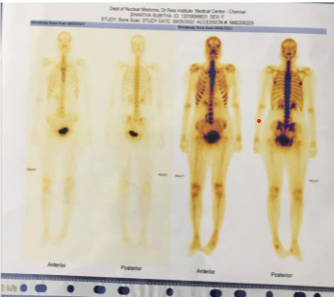A Case Report of Hospital Acquired Resistant Bacterial Infections in a Rituximab Treated Patient with Lupus Vasculitis of Genitourinary Tract
Main Article Content
Abstract
Background and Aims: Integral components of general anesthesia are endotracheal intubation and Laryngoscopy. However hemodynamic responses, such as tachycardia and hypertension, occur immediately and often lasts for 5 to 10 minutes. Hemodynamic responses are exaggerated in hypertensive patients. This study aimed to assess the efficacy of clonidine infusion as a premedication for attenuating hemodynamic reactions of hypertensive patients to laryngoscopy and endotracheal intubation.Methods: This prospective, randomized, controlled study enrolled 60 hypertensive patients of either sex scheduled for surgery under general anesthesia and endotracheal intubation. Patients in clonidine group (C group, n = 30) received intravenous clonidine (4 μg kg-1), diluted in 50 ml normal saline, over 15 minutes by syringe pump pre-operatively, at rate of 200 ml / hr and those in the control group (NS group, n = 30), were given 50 ml normal saline as a placebo in the same manner. The Sedation score of each patient was recorded 15 min after infusion completion. General anesthesia was subsequently given to the patients in both groups in accordance with a prescribed protocol. Hemodynamic parameters were recorded before induction, during laryngoscopy, and at various intervals after laryngoscopy, and statistical analyses were performed. Results: Compared to the control group, the study group had a significantly lower heart rate in all of the recorded readings. There was a significant attenuation of systolic blood pressure and mean arterial pressure in group C compared to those in the NS group. The sedation score after 15 min was significantly higher in Group C than Group NS (p< 0.001). There were no significant variations noticed between the two groups regarding complications that occurred after the operation. Conclusion: Intravenous 4 μg kg-1 clonidine infusion is effective in preventing exaggerated hemodynamic responses during laryngoscopy and tracheal intubation in patients with hypertension.
Article Details
References
Buyon JP, Wallace DJ. The endocrine system, use of exogenous estrogens, and urogenital tract. In: Wallace DJ, Hahn BH, editors. Duboi’s lupus erythematosus. Baltimore: Williams & Wilkins; 1997. pp. 817–34. [Google Scholar]
Orth RW, Weisman MH, Cohen AH, Talmer LB, Nachtsheim D, Zvaifler NJ. Lupus cystitis: primary bladder manifestations of systemic lupus erythematosus. Ann Intern Med. 1983;98:323–6. [PubMed] [Google Scholar]
Kataoka K, Fujioka H, Kitamula K, Kashiwai K, Yoshioka H, Fujita S. Contracted bladder in a patient with systemic lupus erythematosus: report of a case. Acta Urol Jpn. 1980;26:209–13. [Google Scholar]
Weisman MH, McDonald EC, Wilson CB. Studies of the pathogenesis of interstitial cystitis, obstructive uropathy and intestinal malabsorption in a patient with systemic lupus erythematosus. Am J Med. 1981;70:875–81. [PubMed] [Google Scholar]
De La Serna AR, Alacon-Segovia D. Chronic interstitial cystitis as an initial manifestation of systemic lupus erythematosus. J Rheumatol. 1981;8:808–10. [PubMed] [Google Scholar]
Kato K, Okada J, Kashiwajaki S. A case of lupus cystitis with severe urinary bladder contraction and hydronephrosis. Ryumachi. 1985;25:362–8. [PubMed] [Google Scholar]
Leget GA, Czuczman MS.. Use of rituximab, the new FDA-approved antibody. Curr Opin Oncol 1998; 10: 548–551 [PubMed] [Google Scholar]
Edwards JC, Cambridge G.. Sustained improvement in rheumatoid arthritis following a protocol designed to deplete B lymphocytes. Rheumatology 2001; 40: 205–211 [PubMed] [Google Scholar]
Turner-Stokes T, Lu TY, Ehrenstein MR. et al. The efficacy of repeated treatment with B-cell depletion therapy in systemic lupus erythematosus: an evaluation. Rheumatology 2011; 50: 1401–1408 [PubMed] [Google Scholar]
Kado R, Sanders G, McCune WJ.. Suppression of normal immune responses after treatment with rituximab. Curr Opin Rheumatol 2016; 28: 251–258 [PubMed] [Google Scholar]
Hogan J, Avasare R, Radhakrishnan J.. Is newer safer? Adverse events associated with first-line therapies for ANCA-associated vasculitis and lupus nephritis. Clin J Am Soc Nephrol 2014; 9: 1657–1667 [PMC free article] [PubMed] [Google Scholar]
Heusele M, Clerson P, Guery B. et al. Risk factors for severe bacterial infections in patients with systemic autoimmune diseases receiving rituximab. Clin Rheumatol 2014; 33: 799–805 [PMC free article] [PubMed] [Google Scholar]

